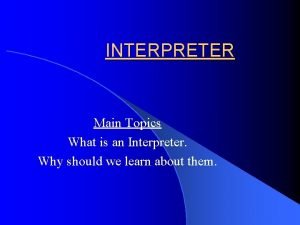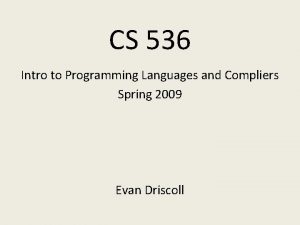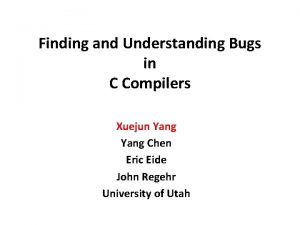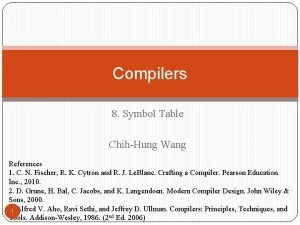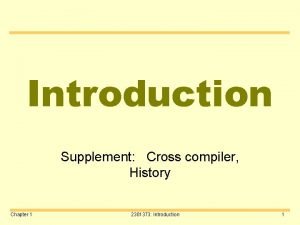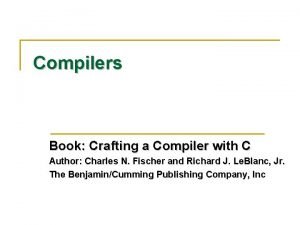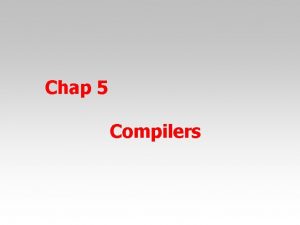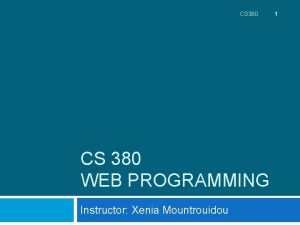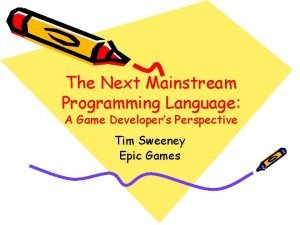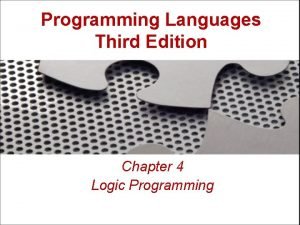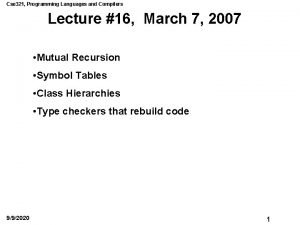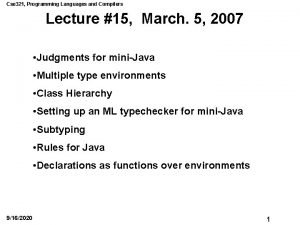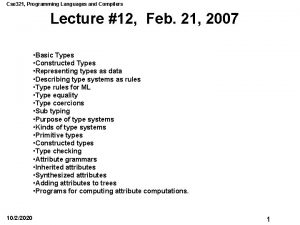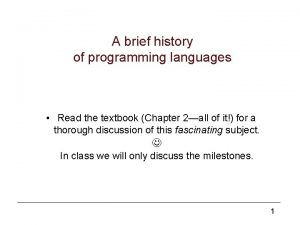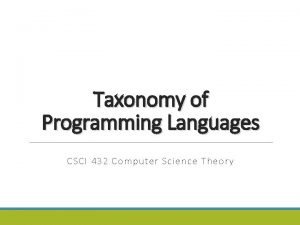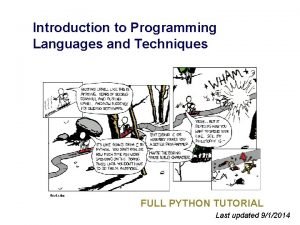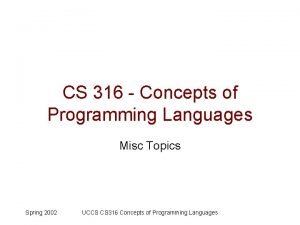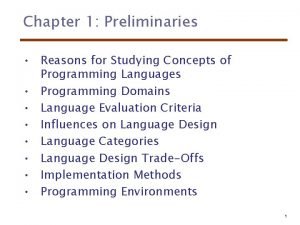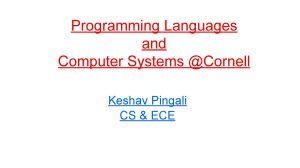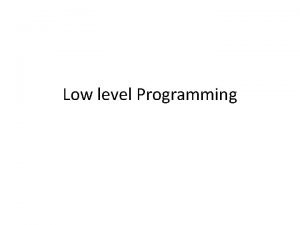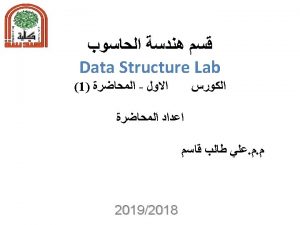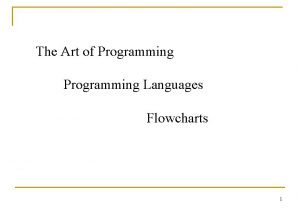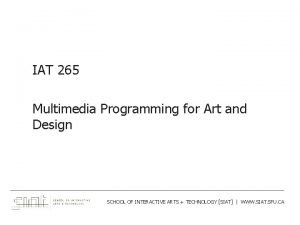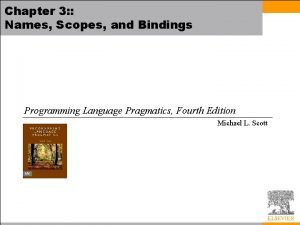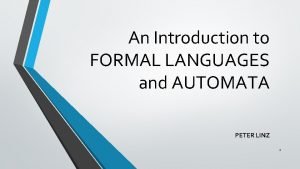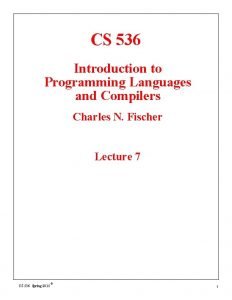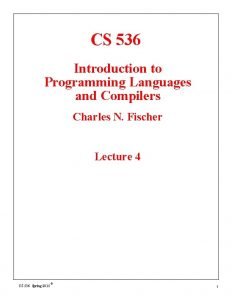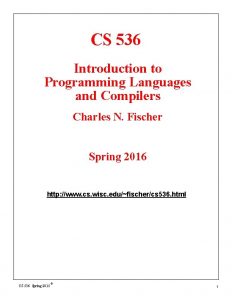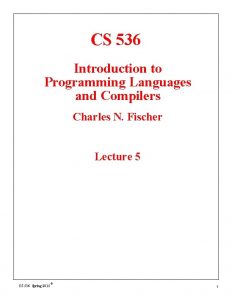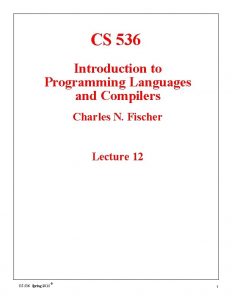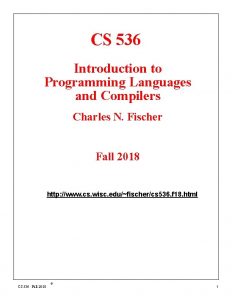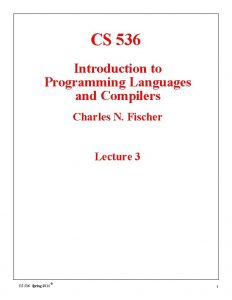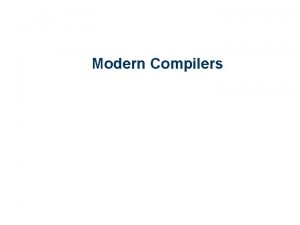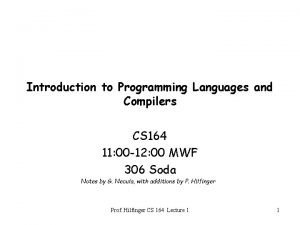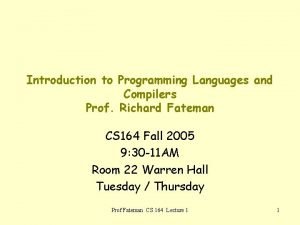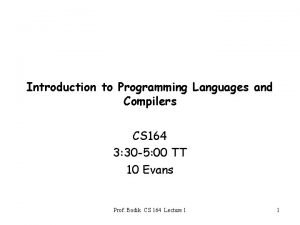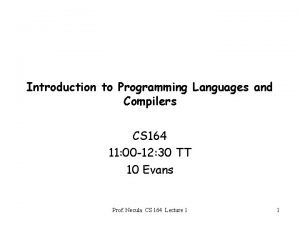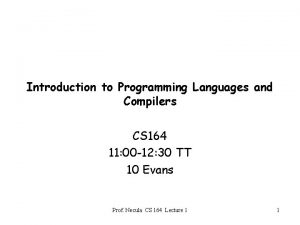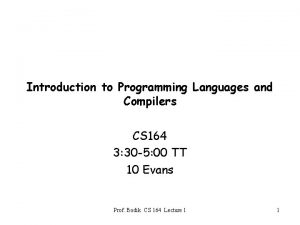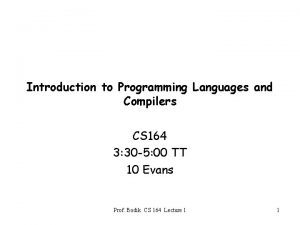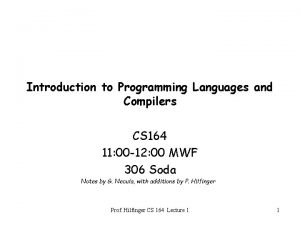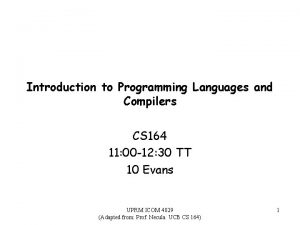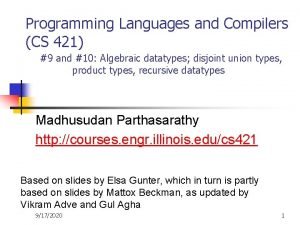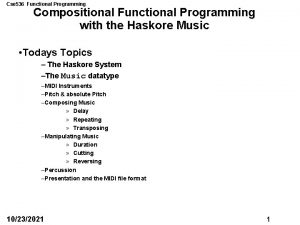CS 536 Introduction to Programming Languages and Compilers





















































- Slides: 53

CS 536 Introduction to Programming Languages and Compilers Charles N. Fischer Lecture 10 CS 536 Spring 2015 © 1

• Midterm Exam #2: Monday, November 19, 5: 30 – 7: 30 PM, in Beatles. Covers LL(1) parsing.

Symbol Tables in CSX is designed to make symbol tables easy to create and use. There are three places where a new scope is opened: • • In the class that represents the program text. The scope is opened as soon as we begin processing the class. Node (that roots the entire program). The scope stays open until the entire class (the whole program) is processed. When a method. Decl. Node is processed. The name of the method is entered in the top- level (global) symbol table. Declarations of parameters and locals are placed in the method’s symbol table. A method’s symbol table is closed after all the statements in its body are type checked. CS 536 Spring 2015 © 31 4

• When a block. Node is processed. Locals are placed in the block’s symbol table. A block’s symbol table is closed after all the statements in its body are type checked. CS 536 Spring 2015 © 31 5

CSX Limits Forward References Except for method references, we can do type-checking in one pass over the AST. As declarations are processed, their identifiers are added to the current (innermost) symbol table. When a use of an identifier occurs, we do an ordinary block- structured lookup, always using the innermost declaration found. Hence in int i = j; int j = i; the first declaration initializes i to the nearest non- local definition of j. The second declaration initializes j to the current (local) definition of i. CS 536 Spring 2015 © 31 6

Forward References to Methods Require Two Passes Since forward references to methods are allowed, we process method declarations in two passes. First we walk the method. Decls AST to establish symbol tables entries for all method declarations. No calls (lookups) are handled in this passes. On a second pass, all calls are processed, using the symbol table entries built on the first pass. Forward references make type checking a bit trickier, as we may reference a declaration not yet fully processed. In Java, forward references to fields within a class are allowed. Thus in CS 536 Spring 2015 © 31 7

class Duh { int i = j; int j = i; } a Java compiler must recognize that the initialization of i is to the j field and that the j declaration is incomplete (Java forbids uninitialized fields or variables). Forward references allow methods to be mutually recursive. That is, we can let method a call b, while b calls a. CS 536 Spring 2015 © 31 8

Incomplete Declarations Some languages, like C+ + , allow incomplete declarations. First, part of a declaration (usually the header of a procedure or method) is presented. Later, the declaration is completed. In C++: class C { int I; public: int f(); }; int C: : f(){return i+1; } CS 536 Spring 2015 © 31 9

Incomplete declarations solve potential forward reference problems, as you can declare method headers first, and bodies that use the headers later. Headers support abstraction and separate compilation too. In C and C+ + , it is common to use a #include statement to add the headers (but not bodies) of external or library routines you wish to use. C+ + also allows you to declare a class by giving its fields and method headers first, with the bodies of the methods declared later. This is good for users of the class, who don’t always want to see implementation details. CS 536 Spring 2015 © 32 0

Classes, Structs and Records The fields and methods declared within a class, struct or record are stored within a individual symbol table allocated for its declarations. Member names must be unique within the class, record or struct, but may clash with other visible declarations. This is allowed because member names are qualified by the object they occur in. Hence the reference x. a means look up x, using normal scoping rules. Object x should have a type that includes local fields. The type of x will include a pointer to the symbol table containing the field declarations. Field a is looked up in that symbol table. CS 536 Spring 2015 © 32 1

Chains of field references are no problem. For example, in Java System. out. println is commonly used. System is looked up and found to be a class in one of the standard Java packages (java. lang). Class System has a static member out (of type Print. Stream) and Print. Stream has a member println. CS 536 Spring 2015 © 32 2

Internal and External Field Access Within a class, members may be accessed without qualification. Thus in class C { static int i; void subr() { int j = i; } } field i is accessed like an ordinary non- local variable. To implement this, we can treat member declarations like an ordinary scope in a blockstructured symbol table. CS 536 Spring 2015 © 32 3

When the class definition ends, its symbol table is popped and members are referenced through the symbol table entry for the class name. This means a simple reference to i will no longer work, but C. i will be valid. In languages like C+ + that allow incomplete declarations, symbol table references need extra care. In class C { int i; public: int f(); }; int C: : f(){return i+1; } CS 536 Spring 2015 © 32 4

when the definition of f() is completed, we must restore C’s field definitions as a containing scope so that the reference to i in i+1 is properly compiled. CS 536 Spring 2015 © 32 5

Public and Private Access C+ + and Java (and most other object- oriented languages) allow members of a class to be marked public or private. Within a class the distinction is ignored; all members may be accessed. Outside of the class, when a qualified access like C. i is required, only public members can be accessed. This means lookup of class members is a two- step process. First the member name is looked up in the symbol table of the class. Then, the public/private qualifier is checked. Access to private members from outside the class generates an error message. CS 536 Spring 2015 © 32 6

C+ + and Java also provide a protected qualifier that allows access from subclasses of the class containing the member definition. When a subclass is defined, it “inherits” the member definitions of its ancestor classes. Local definitions may hide inherited definitions. Moreover, inherited member definitions must be public or protected; private definitions may not be directly accessed (though they are still inherited and may be indirectly accessed through other inherited definitions). Java also allows “blank” access qualifiers which allow public access by all classes within a package (a collection of classes). CS 536 Spring 2015 © 32 7

Packages and Imports Java allows packages which group class and interface definitions into named units. A package requires a symbol table to access members. Thus a reference java. util. Vector locates the package java. util (typically using a CLASSPATH) and looks up Vector within it. Java supports import statements that modify symbol table lookup rules. A single class import, like import java. util. Vector; brings the name Vector into the current symbol table (unless a CS 536 Spring 2015 © 32 8

definition of Vector is already present). An “import on demand” like import java. util. *; will lookup identifiers in the named packages after explicit user declarations have been checked. CS 536 Spring 2015 © 32 9

Classfiles and Object Files Class files (“. class” files, produced by Java compilers) and object files (“. o” files, produced by C and C+ + compilers) contain internal symbol tables. When a field or method of a Java class is accessed, the JVM uses the classfile’s internal symbol table to access the symbol’s value and verify that type rules are respected. When a C or C+ + object file is linked, the object file’s internal symbol table is used to determine what external names are referenced, and what internally defined names will be exported. CS 536 Spring 2015 © 33 0

C, C+ + and Java allow users to request that a more complete symbol table be generated for debugging purposes. This makes internal names (like local variable) visible so that a debugger can display source level information while debugging. CS 536 Spring 2015 © 33 1

Overloading A number of programming languages, including CSX, Java and C+ + , allow method and subprogram names to be overloaded. This means several methods or subprograms may share the same name, as long as they differ in the number or types of parameters they accept. For example, class C {int x; public static int sum(int v 1, int v 2) { return v 1 + v 2; } public int sum(int v 3) { return x + v 3; } } CS 536 Spring 2015 © 33 2

For overloaded identifiers the symbol table must return a list of valid definitions of the identifier. Semantic analysis (type checking) then decides which definition to use. In the above example, while checking (new C()). sum(10); both definitions of sum are returned when it is looked up. Since one argument is provided, the definition that uses one parameter is selected and checked. A few languages (like Ada) allow overloading to be disambiguated on the basis of a method’s result type. Algorithms that do this analysis are known, but are fairly complex. CS 536 Spring 2015 © 33 3

Overloaded Operators A few languages, like C+ + , allow operators to be overloaded. This means users may add new definitions for existing operators, though they may not create new operators or alter existing precedence and associativity rules. (Such changes would force changes to the scanner or parser. ) For example, Class complex{ float re, im; complex operator+(complex d){ complex ans; ans. re = d. re+re; ans. im = d. im+im; return ans; } } complex c, d; c=c+d; CS 536 Spring 2015 © 33 4

During type checking of an operator, all visible definitions of the operator (including predefined definitions) are gathered and examined. Only one definition should successfully pass type checks. Thus in the above example, there may be many definitions of +, but only one is defined to take complex operands. CS 536 Spring 2015 © 33 5

Contextual Resolution Overloading allows multiple definitions of the same kind of object (method, procedure or operator) to co- exist. Programming languages also sometimes allow reuse of the same name in defining different kinds of objects. Resolution is by context of use. For example, in Java, a class name may be used for both the class and its constructor. Hence we see C cvar = new C(10); In Pascal, the name of a function is also used for its return value. Java allows rather extensive reuse of an identifier, with the same identifier potentially denoting a class (type), a class constructor, a CS 536 Spring 2015 © 33 6

package name, a method and a field. For example, Class C{ double v; C(double f) {v=f; } } class D { int C; double C() {return 1. 0; } C cval = new C(C+C()); } At type- checking time we examine all potential definitions and use that definition that is consistent with the context of use. Hence new C() must be a constructor, +C() must be a function call, etc. CS 536 Spring 2015 © 33 7

Allowing multiple definitions to co- exist certainly makes type checking more complicated than in other languages. Whether such reuse benefits programmers is unclear; it certainly violates Java’s “keep it simple” philosophy. In CSX we allow overloading of methods (same name, different parameter combinations). CSX also allows a label to use the same name as any other identifier. CS 536 Spring 2015 © 33 8

Type and Kind Information in CSX In CSX symbol table entries and in AST nodes for expressions, it is useful to store type and kind information. This information is created and tested during type checking. In fact, most of type checking involves deciding whether the type and kind values for the current construct and its components are valid. Possible values for type include: • • Integer (int) Boolean (bool) Character (char) String CS 536 Spring 2015 © 33 9

• • • Void is used to represent objects that have no declared type (e. g. , a label or procedure). Error is used to represent objects that should have a type, but don’t (because of type errors). Error types suppress further type checking, preventing cascaded error messages. Unknown is used as an initial value, before the type of an object is determined. CS 536 Spring 2015 © 34 0

Possible values for kind include: • • Var (a local variable or field that may be assigned to) Value (a value that may be read but not changed) Array Scalar. Parm (a by- value scalar parameter) Array. Parm (a by- reference array parameter) Method (a procedure or function) Label (on a while loop) CS 536 Spring 2015 © 34 1

Most combinations of type and kind represent something in CSX. Hence type==Boolean and kind==Value is a bool constant or expression. type==Void and kind==Method is a procedure (a method that returns no value). Type checking procedure and function declarations and calls requires some care. When a method is declared, you should build a linked list of (type, kind) pairs, one for each declared parameter. When a call is type checked you should build a second linked list of (type, kind) pairs for the actual parameters of the call. CS 536 Spring 2015 © 34 2

You compare the lengths of the list of formal and actual parameters to check that the correct number of parameters has been passed. You then compare corresponding formal and actual parameter pairs to check if each individual actual parameter correctly matches its corresponding formal parameter. For example, given p(int a, bool b[]){. . . and the call p(1, false); you create the parameter list (Integer, Scalar. Parm), (Boolean, Array. Parm) for p’s declaration and the parameter list (Integer, Value), (Boolean, Value) CS 536 Spring 2015 © 34 3

for p’s call. Since a Value can’t match an Array. Parm, you know that the second parameter in p’s call is incorrect. CS 536 Spring 2015 © 34 4

Type Checking Simple Variable Declarations var. Decl. Node ident. Node type. Node Type checking steps: 1. Check that ident. Node. idname is not already in the symbol table. 2. Enter ident. Node. idname into symbol table with type = type. Node. type and kind = Variable. CS 536 Spring 2015 © 34 5

Type Checking Initialized Variable Declarations var. Decl. Node ident. Node type. Node expr tree Type checking steps: 1. Check that ident. Node. idname is not already in the symbol table. 2. Type check initial value expression. 3. Check that the initial value’s type is type. Node. type CS 536 Spring 2015 © 34 6

4. Check that the initial value’s kind is scalar (Variable, Value or Scalar. Parm). 5. Enter ident. Node. idname into symbol table with type = type. Node. type and kind = Variable. CS 536 Spring 2015 © 34 7

Type Checking Const Decls const. Decl. Node ident. Node expr tree Type checking steps: 1. Check that ident. Node. idname is not already in the symbol table. 2. Type check the const value expr. 3. Check that the const value’s kind is scalar (Variable, Value or Scalar. Parm). 4. Enter ident. Node. idname into symbol table with type = const. Value. type and kind = Value. CS 536 Spring 2015 © 34 8

Type Checking Ident. Nodes ident. Node Type checking steps: 1. Lookup ident. Node. idname in the symbol table; error if absent. 2. Copy symbol table entry’s type and kind information into the ident. Node. 3. Store a link to the symbol table entry in the ident. Node (in case we later need to access symbol table information). CS 536 Spring 2015 © 34 9

Type Checking Name. Nodes name. Node ident. Node expr tree Type checking steps: 1. Type check the ident. Node. 2. If the subscript. Val is a null node, copy the ident. Node’s type and kind values into the name. Node and return. 3. Type check the subscript. Val. 4. Check that ident. Node’s kind is an array. CS 536 Spring 2015 © 35 0

5. Check that subscript. Val’s kind is scalar and type is integer or character. 6. Set the name. Node’s type to the ident. Node’s type and the name. Node’s kind to Variable. CS 536 Spring 2015 © 35 1

Type Checking Binary Operators binary. Op. Node expr tree Type checking steps: 1. Type check left and right operands. 2. Check that left and right operands are both scalars. 3. binary. Op. Node. kind = Value. CS 536 Spring 2015 © 35 2

4. If binary. Op. Node. operator is a plus, minus, star or slash: (a) Check that left and right operands have an arithmetic type (integer or character). (b)binary. Op. Node. type = Integer 5. If binary. Op. Node. operator is an cand or cor: (a) Check that left and right operands have a boolean type. (b)binary. Op. Node. type = Boolean. 6. If binary. Op. Node. operator is a relational operator: (a)Check that both left and right operands have an arithmetic type or both have a boolean type. (b)binary. Op. Node. type = Boolean. CS 536 Spring 2015 © 35 3

(7) If binary. Op. Node. operator is and or or: (a) If both left and right operands have a boolean type then binary. Op. Node. type = Boolean. (b) (a) If both left and right operands have an arithmetic type then binary. Op. Node. type = Integer. CS 536 Spring 2015 © 35 3

Type Checking Assignments asg. Node name. Node expr tree Type checking steps: 1. Type check the name. Node. 2. Type check the expression tree. 3. Check that the name. Node’s kind is assignable (Variable, Array, Scalar. Parm, or Array. Parm). 4. If the name. Node’s kind is scalar then check the expression tree’s kind is also scalar and that both have the same type. Then return. CS 536 Spring 2015 © 35 4

5. If the name. Node’s and the expression tree’s kinds are both arrays and both have the same type, check that the arrays have the same length. (Lengths of array parms are checked at runtime). Then return. 6. If the name. Node’s kind is array and its type is character and the expression tree’s kind is string, check that both have the same length. (Lengths of array parms are checked at run- time). Then return. 7. Otherwise, the expression may not be assigned to the name. Node. CS 536 Spring 2015 © 35 5

Type Checking While Loops while. Node stmt. Node ident. Node expr tree Type checking steps: 1. Type check the condition (an expr tree). 2. Check that the condition’s type is Boolean and kind is scalar. 3. If the label is a null node then type check the stmt. Node (the loop body) and return. CS 536 Spring 2015 © 35 6

4. If there is a label (an ident. Node) then: (a) Add label to a list of visible (accessible) labels. (b) Type check the stmt. Node (the loop body). (c) Remove label from the list of visible labels. CS 536 Spring 2015 © 35 7

Type Checking Breaks and Continues break. Node ident. Node Type checking steps: 1. Check that the ident. Node is in the list of visible labels. CS 536 Spring 2015 © 35 8

Type Checking Returns return. Node expr tree It is useful to arrange that a static field named current. Method will always point to the method. Decl. Node of the method we are currently checking. Type checking steps: 1. If return. Val is a null node, check that current. Method. return. Type is Void. 2. If return. Val (an expr) is not null then check that return. Val’s kind is scalar and return. Val’s type is current. Method. return. Type. CS 536 Spring 2015 © 35 9

Type Checking Method Declarations (no Overloading) method. Decl. Node ident. Node type. Node args tree decls tree stmts tree Two passes over the AST for method declarations are used. Type checking steps (pass 1): 1. Create a new symbol table entry m, with type = type. Node. type and kind = Method. 2. Check that ident. Node. idname is not already in the symbol table; if it isn’t, enter m using ident. Node. idname. CS 536 Spring 2015 © 36 0

Type checking steps (pass 2): 1. Create a new scope in the symbol table. 2. Set current. Method = this method. Decl. Node 3. Type check the args subtree. 4. Build a list of the symbol table nodes corresponding to the args subtree; store it in m. 5. Type check the decls subtree. 6. Type check the stmts subtree. 7. Close the current scope at the top of the symbol table. CS 536 Spring 2015 © 36 0

Type Checking Method Calls (no Overloading) call. Node ident. Node args tree We consider calls of procedures in a statement. Calls of functions in an expression are very similar. Type checking steps: 1. Check that ident. Node. idname is declared in the symbol table. Its type should be Void and kind should be Method. CS 536 Spring 2015 © 36 2

2. Type check the args subtree. 3. Build a list of the expression nodes found in the args subtree. 4. Get the list of parameter symbols declared for the method (stored in the method’s symbol table entry). 5. Check that the arguments list and the parameter symbols list both have the same length. 6. Compare each argument node with its corresponding parameter symbol: (a) Both must have the same type. (b) A Variable, Value, or Scalar. Parm kind in an argument node matches a Scalar. Parm parameter. An Array or Array. Parm kind in an argument node matches an Array. Parm parameter. CS 536 Spring 2015 © 36 3
 Cs 421
Cs 421 Cs 421 uiuc
Cs 421 uiuc Introduction to programming languages
Introduction to programming languages What is an interpreter
What is an interpreter Fhwa 536 form
Fhwa 536 form Cs 536
Cs 536 Liedboek 536
Liedboek 536 Finding and understanding bugs in c compilers
Finding and understanding bugs in c compilers Symbol table implementation in lex and yacc
Symbol table implementation in lex and yacc Introduction to compiler and interpreter
Introduction to compiler and interpreter Real-time systems and programming languages
Real-time systems and programming languages Advantages and disadvantages of system software
Advantages and disadvantages of system software Real time programming language
Real time programming language Compilers binarymove
Compilers binarymove Cousins of compiler
Cousins of compiler Crafting a compiler
Crafting a compiler Functions of compilers
Functions of compilers Depict structure of front end of a compiler
Depict structure of front end of a compiler Multithreading program in java
Multithreading program in java Programming languages levels
Programming languages levels Plc programming languages
Plc programming languages Procedural programming languages
Procedural programming languages Imperative programming languages
Imperative programming languages Alternative programming languages
Alternative programming languages Strongly typed vs weakly typed
Strongly typed vs weakly typed Transmission programming languages
Transmission programming languages Adam doupe cse 340
Adam doupe cse 340 Integral data type
Integral data type Xenia programming languages
Xenia programming languages Mainstream programming languages
Mainstream programming languages Cse 340 principles of programming languages
Cse 340 principles of programming languages Programing languages
Programing languages Programming languages
Programming languages Programming languages
Programming languages Programming languages
Programming languages Tiny programming language
Tiny programming language Brief history of programming languages
Brief history of programming languages Taxonomy of programming languages
Taxonomy of programming languages High level language
High level language If programming languages were cars
If programming languages were cars Reasons for studying concepts of programming languages
Reasons for studying concepts of programming languages Cornell programming languages
Cornell programming languages Low level linux programming
Low level linux programming Middle level programming languages
Middle level programming languages Programming languages flowchart
Programming languages flowchart Multimedia programming languages
Multimedia programming languages Storage management in programming languages
Storage management in programming languages An introduction to formal languages and automata
An introduction to formal languages and automata Language
Language Perbedaan linear programming dan integer programming
Perbedaan linear programming dan integer programming Greedy algorithm vs dynamic programming
Greedy algorithm vs dynamic programming Components of system programming
Components of system programming Linear vs integer programming
Linear vs integer programming Programing adalah
Programing adalah



